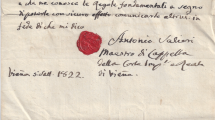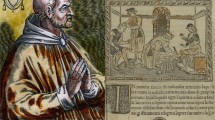Abstract
Purpose
Current literature describes that art can be used to teach observation skills in medical students. In this way, many medical schools have developed formal observational training on works of art to improve their students’ visual diagnostic skills. In this context, this description presents unprecedented evidence that Sandro Botticelli (1445–1510) may have represented a rare neuromuscular disorder, known as Pompe disease (accumulation of lysosomal glycogen primarily in the heart, skeletal muscles, and the nervous system) in one of the characters that make up Virgin and Child with the Infant St. John the Baptist (1490–1500).
Methods
Observational study.
Results
The painting reveals that the Infant Jesus has facial features consistent with some of the main clinical manifestations of Pompe disease (poor head control, facial weakness with open mouth posture, tongue protrusion, and eyelid ptosis).
Conclusion
These results may indicate that Botticelli in 1500 may have made the first pictorial representation of Pompe’s disease that was only described in the medical literature in 1932. Furthermore, this description demonstrates the importance of the medico-artistic field for the study of any disease during the Renaissance period, which will be essential for the learning process of visual diagnostic.

Similar content being viewed by others
References
Bell LT, Evans DJ (2014) Art, anatomy, and medicine: is there a place for art in medical education?. Anat Sci Educ 7:370–378
Moore CM, Lowe C, Lawrence J, Borchers P (2011) Developing observational skills and knowledge of anatomical relationships in an art and anatomy workshop using plastinated specimens. Anat Sci Educ 4:294–301
Lazzeri D, Castello MF, Grassetti L, Dashti T, Zhang YX, Persichetti P (2015) Foot deformities in Renaissance paintings. A mystery of symbolism, artistic licence, illusion and true representation in five renowned Renaissance painters. J R Coll Physicians Edinb 45:289–297
Dahan S, Shoenfeld Y (2017) A picture is worth a thousand words: art and medicine. IMAJ 19:772–776
Fecarotta S, Ascione S, Montefusco G, Della Casa R, Villari P, Romano A, Del Giudice E, Andria G, Parenti G (2013) Improvement of dysphagia in a child affected by Pompe disease treated with enzyme replacement therapy. Ital J Pediatr 39:30
Fatehi F, Ashrafi MR, Babaee M, Ansari B, Beiraghi Toosi M, Boostani R, Eshraghi P, Fakharian A, Hadipour Z, Haghi Ashtiani B, Moravej H, Nilipour Y, Sarraf P, Sayadpour Zanjani K, Nafissi S (2021) Recommendations for infantile-onset and late-onset Pompe disease: an Iranian consensus. Front Neurol 12:739931
Salabarria SM, Nair J, Clement N, Smith BK, Raben N, Fuller DD, Byrne BJ, Corti M (2020) Advancements in AAV-mediated gene therapy for Pompe disease. J Neuromuscul Dis 7:15–31
Ashrafian H (2022) Differential diagnosis of a thyroid mass, facial malar rash and ptosis on the flora in the primavera by Sandro Botticelli (1445–1510). J Endocrinol Invest 45:687–689
Pozzilli P, Vollero L, Colao AM (2019) Venus by Botticelli and her pituitary adenoma. Endocr Pract 25:1067–1073
Di Rocco C (2006) Botticelli and the Babinski sign. Childs Nerv Syst 22:1061–1062
Brigo F, Caglioti F (2021) Babinski sign in the only existing sculpture by Leonardo. Childs Nerv Syst 37:1029–1031
Blech B, Doliner R (2008) The sistine secrets: Michelangelo’s forbidden messages in the heart of the Vatican. HarperCollins Publishers, New York
Lightbown R (1989) Botticelli: life and work. Abbeville Press, New York
Cecchi A (2007) Botticelli e l’età di Lorenzo il Magnifico (I grandi maestri dell’arte. L’artista e il suo tempo). E-ducation.it, Firenze
Author information
Authors and Affiliations
Contributions
The entire manuscript was written and organized by Deivis de Campos.
Corresponding author
Ethics declarations
Ethics approval and consent to participate
Not applicable.
Consent for publication
Not applicable.
Competing interests
The authors declare no competing interests.
Conflict of interest
The author confirms that this report or any of its contents have not been previously published or presented, and that it is not currently under consideration by any other journal. The author also declares that there is no conflict of interest concerning this report or any of its findings, nor are there any financial disclosures required. Patient consent was not required for this description as there are no patient identifiable details or protected health information included within this manuscript.
Additional information
Publisher's Note
Springer Nature remains neutral with regard to jurisdictional claims in published maps and institutional affiliations.
Rights and permissions
About this article
Cite this article
de Campos, D. The Virgin and Child with the Infant St. John the Baptist by Sandro Botticelli (1445–1510): does the child have Pompe disease?. Childs Nerv Syst 38, 1267–1269 (2022). https://doi.org/10.1007/s00381-022-05537-0
Received:
Accepted:
Published:
Issue Date:
DOI: https://doi.org/10.1007/s00381-022-05537-0




